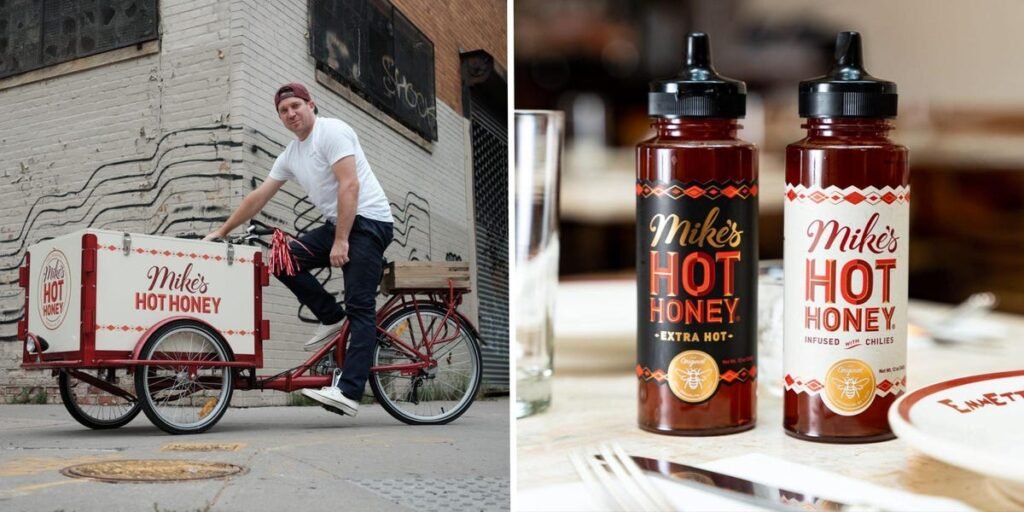Mike’s Hot Honey, ubiquitous in US grocery stores and pizza chains, technically got its start in Brazil.
It was 2003. Mike Kurtz was a junior in college, completing a semester in Salvador. After a national park trip, Kurtz and his friends stopped at a pizzeria for lunch. The shop had an unusual condiment, one he hadn’t seen before: honey infused with whole chili peppers.
When Kurtz returned to America, he spent his senior year tinkering with his own version, a more homogenous mixture “with a really nice level of heat that could cut through a slice of pizza,” Kurtz, now 43, told Business Insider.
He started making jars of hot honey for friends and family as a hobby. Kurtz loved to cook, often making homemade pizzas to accompany his honey creations.
It took six years for Mike’s Hot Honey to leave the hobby phase. Kurtz spent years working in the music industry and later, as a travel blogger. Still, the idea of turning his hot honey side hustle into a business stuck: Kurtz finally started selling jars of it at a popular Brooklyn pizzeria in 2010.
In 2025, over 20 years since Kurtz first ate that fateful slice in Brazil, Mike’s Hot Honey is projected to make $60 million, earning 60% of its revenue in retail and the rest in food service. Trailblazing the “swicy” food trend, the brand recently announced collaborations with KFC, Dunkin’, and Heineken, as well as with famed pizzerias like Chicago’s Lou Malnati’s.
Kurtz shared tips on how to stay committed to an idea, even when life gets busy — or when you worry it’s too late to take a career risk.
Stay curious
Kurtz spent his senior year of college at UMass taking frequent trips to New York City. After doing some online research, he was drawn to a unique location: the Hunts Point Produce Market in the Bronx, where many of the city’s restaurants get their produce.
Open from 10 p.m. to 10 a.m., the market was the best place to find the widest range of chilies, especially in the mid-aughts, when his college town’s options were limited to jalapeños. “I was just curious, the first time I went there,” he said.
He found it to be “like a stock market for produce” and would go down on weekends with a half gallon of whole milk in his backpack. He’d take sips between taste-testing peppers at the market as a way to clean his palate, then bring bags of peppers back home.
Kurtz tried different infusion techniques in his apartment, drizzling each batch on slices of pizza. He said that a genuine interest in hot honey and pizza made it easy to stay committed to finding a recipe that worked.
Kurtz, who describes himself as a “generally curious person,” also found his future employer — and the official starting point of Mike’s Hot Honey — by poking around on a now-defunct pizza blog called Slice.
He kept seeing the same handle in the comments section. “I’m like, who is this guy? He’s a serial commenter on every post,” he said. Kurtz later read a profile of the commenter, Paul Giannone, known as Paulie Gee, who made wood-fired pizzas in his Greenpoint apartment. Later, when Giannone opened his famed Brooklyn pizza restaurant Paulie Gee’s, Kurtz followed as a pizza maker, eventually selling his hot honey there.
Get early feedback
Right from the beginning, Kurtz received feedback on his idea: he gave away homemade jars as holiday gifts to his loved ones. Some told him the hot honey was really good and could be a business someday, an idea that he didn’t pursue at the time.
Nonetheless, knowing people liked his product gave him emotional fuel to persevere. That is what pushed him to approach Giannone with his hot honey. It became a central ingredient in the restaurant’s “Hellboy” slice, now its most popular pie.
Working from the restaurant’s open kitchen — what Paulie Gee’s staff referred to as the “pizza theater” — Kurtz could watch people’s reactions as they bit into the Hellboy. Gradually, he started making and selling containers of Mike’s Hot Honey from the counter at Paulie Gee’s, gaining popularity by word of mouth. Eventually, he found a distributor and sold Mike’s Hot Honey to its first retailer, Whole Foods, in 2014.
He said getting early, positive feedback was crucial to his success because it motivated him to continue. “Don’t be afraid to just launch something, as new and rough around the edges as it is,” Kurtz said. “It gets a lot easier to make adjustments to an idea than trying to fine-tune something in your own echo chamber.”
Spend time with successful risk-takers
At 29, Kurtz’s career in music was affected by the 2008 recession. The industry was “not in a healthy place,” he said, and he split his time between working at a booking agency and moonlighting as a pizza maker at Paulie Gee’s.
Kurtz had a dilemma: he loved making pizza, and he wanted to give his hot honey dream a shot by incorporating it into the restaurant’s menu. At the same time, he was almost 30 and had invested nearly his entire career into music supervision. In a tough economic climate, he felt lucky to have his booking agency job.
“Even young people sort of get it in their head that it’s too late for them to switch gears and try something different,” Kurtz said.
Getting to know Giannone helped him make a decision. At 56, Giannone quit his 30-year IT career to open a restaurant — despite having no formal restaurant experience.
Seeing how the risk paid off for Giannone influenced Kurtz’s own leap of faith. Even in the early days of Paulie Gee’s, “you could see he was so happy in the restaurant,” Kurtz said. “Witnessing Paulie’s journey of opening the pizzeria, that gave me the confidence I needed to really go for it with the honey.”
Read the full article here

















